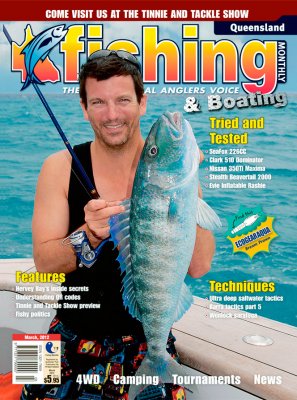Hervey Bay’s inner secrets by Phil James
 Hervey Bay has a well-deserved reputation for fishing that most serious anglers would love to explore. There are plenty of opportunities for catching a variety of reef species as well as bream, whiting, flathead and a number of visiting pelagics. And all of which can be found in the secrets of the Bay's inner reefs.
Hervey Bay has a well-deserved reputation for fishing that most serious anglers would love to explore. There are plenty of opportunities for catching a variety of reef species as well as bream, whiting, flathead and a number of visiting pelagics. And all of which can be found in the secrets of the Bay's inner reefs.
Hervey Bay boat harbour at Urangan has two excellent ramps, each with four lanes and an adequate vehicle park. A small pontoon is provided near the northern ramp, and a new longer pontoon between the ramps is under construction. This should make launching and retrieving boats a much more enjoyable task.
In good conditions, offshore craft can head for the prolific reef and game fishing grounds north and west of Fraser Island. Other crews can even contemplate the run through the Sandy Cape Spit to the shoals, or even the Gardner Banks. The not so adventurous can set their sights on popular spots such as Meringa Pinnacles, Moon Ledge, Outer Banks or Bogimbah Ledge. Smaller and less powerful craft, can leave the harbour knowing that within five minutes, ten at the most, they will be fishing.
THE INNER REEFS
The Channel
Just minutes from the harbour entrance, the main channel covers an assortment of rocky ledges in up to 10m of often swiftly flowing water. They extend from a little south of the harbour towards the Urangan Pier and across to the shallow waters to Round Island where they become part of the shallow reef system.
There are no particular hot spots here although many anglers, myself included, tend to return to the same marks on each outing. It is just a matter of sounding the area and picking up a good ledge or other interesting feature, and anchoring suitably up-current. For the record, my regular mark is at 25º 17.58' S, 152º 54.6' E, a good starting point that is regularly productive.
This main channel experiences strong currents, particularly on spring tides, and although some good catches are made throughout a neap run, the best plan is to work each side of either the top or bottom of a tide. I prefer to fish over the bottom of the tide, as I prefer to fish some of the more shallow reefs over the high water. On occasions, working the last of the ebb will produce plenty of action, then when you expect fish to really fire on the flood, all goes quiet. Of course, exactly the opposite sequence of events often happens.
The full range of reef fish is available here and I will address species and tactics further on.
Round Island
As an extension of the rocky ledges of Round Island, a coral and rock reef extends north to a point about 200m west of the yellow buoy. Small boats travelling from the harbour need to keep this buoy to port, and not wander too far to the east particularly at low tide.
There is plenty of tidal flow on the flood tide but on the ebb, particularly close to Round Island, the flow is minimal due to the current deflecting effect.
A lot of this reef is made up of very heavy coral and rock structures, and can be very hard on terminal tackle. My preference is to fish along the reef edges or areas where the coral structures are more scattered. On very low tides, the reef bares close to Round Island and close to its northern extremity.
Woody and Green Zone
North and east of the Round Island system, is a broad area of shallow reef that extends from the shallows towards the red beacon and north cardinal beacon with a prominent blind gutter bisecting it. Tidal flow tends to be greatest before and after the top of the tide while on the lower ebb tides there is less run off the shallows to the south. While most of the reef is made up of scattered rock and coral, there are some very heavy patches.